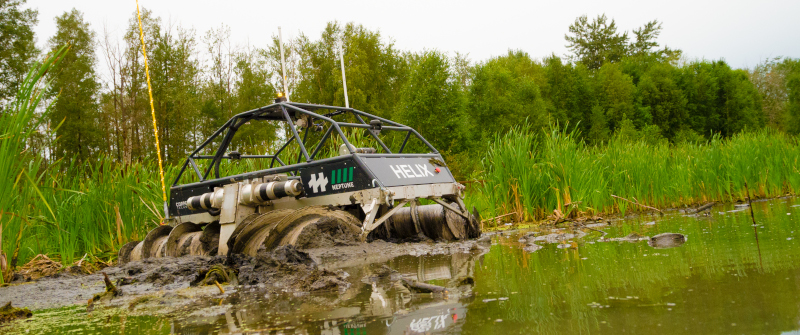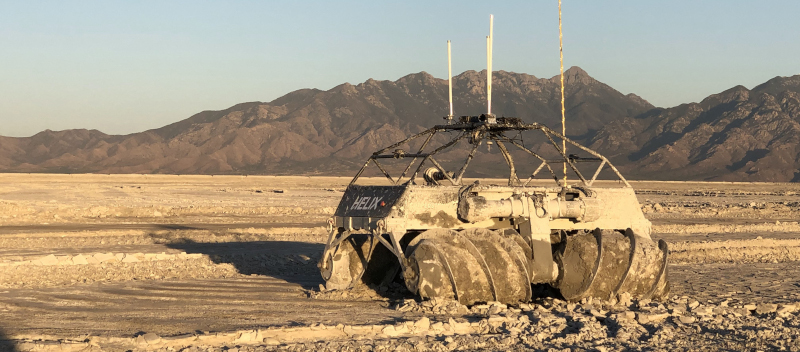
Tailings Rover
Mike McLeod
Automation General EnergyCopperstone Technologies’ amphibious Helix robot mitigates the risks of monitoring tailings ponds.

Copperstone Technologies’ 400 kg amphibious HELIX Neptune robot has a 100 kg payload capacity and travels up to 15 kph on hard land and cruises at 2-3 m/s (3-4 knots) on water.
(Photo credit: Copperstone Technologies)
For the oil sands and mineral extraction industries, tailings ponds are an environmental and regulatory nightmare. Often massive structures, they are designed to “temporarily” contain extraction by-products – often a mixture of water, sand and clay, as well as residual bitumen and other hazardous chemicals–until the solids in the slurry settle out over time.
While most of the clarified water at the top of the pond is re-used, what remains is a toxic sludge, called fine fluid tailings (FFT), that can take years to decades to dry out sufficiently for the pond to be reclaimed. During that “dewatering” process, environmental regulations require that tailings ponds and dams be regularly monitored.
For the Alberta oil sands, the burden is only growing. According to a 2021 report by the Alberta Energy Regulator (AER), tailings ponds currently contain 1.36 billion cubic meters of fluids that cover a surface 1.7 times the size of Vancouver. Taking regular depth readings, core samples and other measurements over that vast an area is a lengthy and difficult process.
To complicate matters, the terrain in a tailings pond can include radical extremes, from deep water to hard packed earth and dry sand to sticky mud. Sending field workers into this environment requires numerous safety and rescue measures.
“Imagine walking across a lake of peanut butter and the hazard becomes immediately obvious,” says Copperstone Technologies CEO, Craig Milne. “You can’t drive a truck or float a boat across that kind of material. And then, because these facilities can cover several square miles, you also get all sorts of debris and open pits of water in areas. It’s all of that terrain together that makes the environment hazardous and challenging.”
To mediate this sticky predicament, the Alberta-based robotics-as-a-service firm has engineered the HELIX all-terrain robot, a screw-driven amphibious robot that can autonomously navigate over nearly anything, its creators say.
Copperstone’s HELIX robots are distinctive for their “tires,” four hollow aluminum pontoons wrapped in helical projections that serve as both flotation and propulsion.
On snow, gravel and other hard surfaces, the robot moves similar to any wheeled vehicle – in the same direction as the rotation of the tires – while the opposing screw projections provide traction. As the terrain becomes more muddy and watery, however, the robot shifts 90 degrees to allow the screws to function as propellers.
“The design is actually a 100-year-old concept,” Milne explains. “One of the upgrades we’ve added to the traditional vehicles is that we have two screws on each side that rotate in opposite directions. That’s critical in that it allows us to both steer better and also roll sideways, which is very efficient on hard ground. And then, once we hit soft material, we change 90 degrees and screw forwards so we can basically move axially through anything from snow, water or mud.”
The HELIX robot and its innovative propulsion is the brainchild of Copperstone’s co-founders, Nicolas Olmedo, Stephen Dwyer and Jamie Yuen. The three University of Alberta engineering school post-grads shared a fascination for robotics and an advisor, mechanical engineering profession Dr. Mike Lipsett, who encouraged them to explore their entrepreneurial spirit.
Toward that end, the trio engaged with Mitacs, the Canadian not-for-profit that pairs private companies with research specialists at Canadian universities. Their first project involved designing a prototype tracking system for vehicles. Rather than accept a job to finish the project, they established Copperstone Technologies to serve as an independent contractor.

The 800kg HELIX AR2 is capable of carrying 300 kg of gear and is typically used to carry out geotechnical surveys to test the bearing strength of the tailings pond.
(Photo credit: Copperstone Technologies)
After finishing that project, the team wanted to return to robotics. Based on conversations with an oil sands industry contact they met through Dr. Lipsett, the Copperstone founders began applying their own research on terramechanics, the study of the interaction of wheeled or tracked vehicles on soil, to the tailings pond monitoring problem.
“At the time, I was reading a lot of books on military vehicles and space robotics, and in one of those books from the ’60s, I had seen a picture of the screwdriver vehicle,” Copperstone CTO, Nicolas Olmedo explains. “So when we were thinking seriously about how to make something move on tailings and we knew that tracks and wheels would get stuck, we thought, why don’t we try screw-drive propulsion.”
Apart from a Russian space race era text on designing a cosmonaut retrieval vehicle, however, the Copperstone Technologies team had little research to go on and had to learn the intricacies of screw-drive propulsion in the field.
“The most difficult thing was figuring out how much power we would need to rotate the scrolls in tailings because it will stick to them like very sticky yogurt or black honey,” Olmedo says. “At first, we thought to use bigger motors, but to carry the weight of bigger motors and bigger batteries, you need a bigger [robot]. And then with a bigger [robot], we probably need more power to rotate it. It became like a design cycle.”
Over the past eight years since the lessons learned from those early prototypes, Copperstone has developed its current line of HELIX robots, the AR2 and the Neptune. The heftier 800kg HELIX AR2 is capable of carrying 300 kg of gear and is typically used to carry out geotechnical surveys to test the bearing strength of the tailings pond.
The newer 400 kg HELIX Neptune is fully amphibious and has a 100 kg payload capacity. On hard land, the Neptune travels up to 15 kph, down to around 1 m/s (3.6 kph) as the terrain becomes muddier. On water, the Neptune cruises at 2-3 m/s (3-4 knots).
Both robots can last for several hours between charges, the company says, on its lithium polymer battery packs that can be swapped on site. Equipped with cameras and GPS tracking, the robots can be piloted in the field via a hand-held controller or programmed to autonomously navigate using waypoints without oversight. In addition to the HELIX robots themselves, Milne says the engineers at Copperstone have also perfected automating the test equipment the robots carry, thereby reducing the personnel needed on site to a minimum.
“The real vision in the future is actually to become much like the NASA control room,” Milne says. “Our operators could then monitor and maintain a number of different robots at a distance, but we’d also have somebody located onsite to make sure things are operating safely.”
While Milne can’t reveal particulars, he says their client list is a who’s who of the resource industry, including work for Imperial Oil in Alberta and global mining company, Vale, to perform unmanned geotechnical investigations for its Brazilian operations.
In addition to oil sands and mining, the company says its ultimate vision is to expand its services offworld. “In a very low gravity environment, like asteroids, wheels and tracks don’t work,” Olmedo explains. “So the latest in space exploration technology is that screw drives are probably the best suited for super low or microgravity environments. We’re thinking seriously about that.”
https://copperstonetech.com
